HOME |
LOGBOOK |
|
July 26,
2001 Greg
had never even seen Tackless II before, let alone gone cruising,
nor had he ever traveled
From
there we gave him a whirlwind intro to the Panama Canal at the MiraFlores
Locks and then it was off on the first of our busses back. Things
were pretty slick on Bus #1, an air-conditioned "Ejecutivo"
complete with movie and cushy seats, but in Santiago we switched
to the local bus On
Day Two the highlight would have to be our afternoon meal at Gladys's.
Gladys's is a popular eatery overlooking the river at which the
2Cs were already regulars. Gladys's is not the kind of place Greg
had ever eaten in before, and indeed he speculated on whether his
wife Karen, were she present, WOULD. Maybeit was the vultures clattering
around on the tin roof waiting for scraps to eject from the kitchen
or maybe it was the somewhat casual sense of sanitation…I dunno.
But the fact is the food is GOOD. We had various kinds of shrimps
in various kinds of sauce with each plate We pulled anchor early on Wednesday and departed Puerto Mutis as the tide started to ebb. The morning was gorgeous, and we made a fast trip down the river and west back to Isla Gubenadora (07-34.00N; 081-11.40W) for our first stop. Still in the Bahia Montijo, the water was not inviting yet for swimming so we made do with an afternoon of reading and a big dinner of wahoo and mango salsa. The next day, we found our first clear water and white sand beach at our lunch stop at Isla Catalina, a few miles to west. Greg got his first intro to snorkeling there, but there wasn't much fishlife, so we moved on that afternoon, motoring along nearly twenty miles of undeveloped coastline to surely one of the most gorgeous bays we have ever seen, Bahia Honda. Bahia
Honda (07-45.10N; 081-32.70W)is the kind of place you could stay
for a month: protected and beautiful, with many coves, palm fringed
honeymoon beaches and tiny islets, surrounded by layers of hills
rising to mountains uncut by any road, rainforests resounding with
the cries of howler monkeys, parrots and cicadas, and friendly locals
who glide out across the water in dugout canoes to trade bananas
and limes for things they really need. We only gave it three We got an up close look at all the construction when our nosing around resulted in being adopted by Simon, the architect of the whole shebang. Simon is a handsome young man with an Indiana Jones look about him who hails from the mountain country of Colombia. His specialty is construction, using bamboo in what seems to us a very modern application, as well as some unusual use of stone and natural woods, specifically pillars made from tree trunks honed and sanded down to their hearts! The building we found him in is on the shore of Bahia Honda itself. It was a huge rectangular roof of bamboo poles, reinforced with concrete, to be topped by insulation and Spanish tile, with concrete floors and supports covering an area which we'd guess would measure about 75 feet by 180! This turned out to be the living room, dining area and kitchen for the guests, who would sleep in two separate houses of two separate accommodations each up the hillside! If
we were impressed with that, it was nothing compared to the private
residence going up on the very top of Isla Medidor, an island just
to the west of the entrance to Bahia Honda. Simon took us to see
this glimpse of the rich and famous, which became quite an adventure.
It started with an hour-long dinghy ride. (In the future we will
remember to inquire, "How far it is?" and Simon will learn
to ask "How big is you outboard?") Safely landed on the
beach of an anchorage big enough for the megayacht, we found ourselves
in a "train station" built into a bridge of concrete and
more bamboo. The "train" consisted of a monorail ascending
the 700 feet to the summit at an incredible angle of about 60 degrees.
The locomotive was a gas-driv We
didn't see any of the research buildings, some of which are already
underway. And there will be a marina, to be accessed by another
train track. Simon has 100 workers, about 15 of which came with
him from Colombia. They've been working since December, and Simon
figured he, at least, would be there a couple more years. (Note:
the insides of these buildings are being designed by a different
architect, PLUS the house for the other partner hasn't been started
yet!) What is really astounding about all this is how far away from
civilizatio The day after our adventure into rich-and-famous fantasyland, it rained all day in proper Panama fashion. I did a little solo scuba dive under the boat doing search patterns for my sunglasses that were unaccounted for (I have been known to dive in with them hanging from their Croakie!) I didn't find the glasses (they turned up two days later in the laundry!), but I did see all sorts of bottom life, including a HUGE nurse shark that snuck up beside me to check me out. We gave each other quite the start! Sunday dawned a perfectly gorgeous day, and we sailed onward to the Secas Island group with dolphins leaping around us and a big fat fish on the trolling line. Little brother reeled him in, muscles flexing etc. Imagine our disappointment - this is the first fish we've boated in the Pacific - when we identified him as a black skipjack tuna, which our newest fishing guide annotates as "see if you can get the cat to eat it!" The Secas (07-59.30N; 082-01.80W) finally brought us clear water! Here at last we were able to take Greg up a notch into scuba diving. We did our little course on the beach, and it is probably the first I have ever done with a free-swimming green moray at hand! Greg did well, so, we collected Don and went for a fabulous dive on the outside of a little island with 60-foot visibility and dense schools of big fish. Don and I were thrilled with all the different varieties - especially the Pacific Spadefish, huge triggers, plus another half dozen free-swimming morays! Don saw a turtle and I saw a mahi mahi! Greg was thrilled that we were thrilled. Like most new divers, he was thrilled with kicking and breathing and getting back alive. He did great, stayed cool and steady, and actually talked about certification afterwards…once his ears cleared. The Secas also brought us other cruisers, three boats we'd been talking to on the radio nets but had never met. This made for a few social exchanges, chief of which was a trash burning party on the beach at sunset. No one had marshmallows, but the gals and Greg got into shell collecting. Also, when two big shrimpers joined us in the anchorage, the women got together with a bag of trading items and three empty buckets and made an excursion to barter. We returned with buckets brimming, which set all hands to peeling shrimp for hours. We stayed at the Secas four nights, and we probably should have stayed longer, because the water around our next stop, Parida and it satellites, proved unsuitable for any more diving. Topside, it was great, though. Isla Gamez (08-07.70N; 082-19.00W), our first anchorage, was postcard perfect with a white beach studded with coconut palms in a saddle between two forested humps. The water was emerald and balmy for swimming, and the woods filled with birdsong. Most suitable for lolling, at which Greg was quickly becoming cruiser-proficient. However it was time to line up the panga for Greg's return to civilization via another river system (not easily accessible to Tackless…or the nerves of the two captains) to the city of David. We'd been told the panga would find us, but the days passed and no one came by. So, we hailed some fisherman who guided us in our dinghy down to the south end of Parida to meet and negotiate with another panga driver, Theodo (and Theodo's wife). The hitch with getting good enough at Spanish that people understand you, is that they think you can understand them, and they speak a mile a minute. Still, I was pretty confident all was arranged, complete with negotiated price and a handshake, and to cement it we moved the boat down to the southern anchorage of Parida, right off Theodo's front yard (08-05.60N; 082-20.40W) This got a bit exciting as a couple of hours after we had set our anchor, we were hit by a whopper squall out of the northeast packing winds well over 30 knots. The boat went from riding gently facing west, abruptly 180 degrees traveling rapidly on the 120' radius of our rode towards the lee shore of Theodo's beach! Taking this opportunity to demonstrate for Greg our calm cool coordination of effort under stress, the 2Cs didn't wait to see if the anchor would stop us, but fired up old Perky, picked up the anchor and reset in deeper water even as the rain and wind were howling. We'd like to think he was impressed. This squall, the first such weather we'd seen since San Blas last December, gave us our first second-thoughts about lithely leaving the boat unattended here for the two days we'd need to make the Pedregal panga trip. However, a little back weather analysis revealed that the squall, probably a tropical low by the time it blew through, was travelling along at the tail end of a passing tropical wave from the Caribbean. Looking ahead, the weather picture was clear, so we set a second anchor and went ahead with our plans. Monday dawned yet another perfect sunny day, and by seven am we were packed, coffee'd and RTG, but no sign of Theodo. We exercised tropical patience for about two hours, before we went looking for him, tracking him down "at work" on the nearby island of Paratita! Seems there was a little confusion, but his employers, two landed yachties care-taking some getaway cabanas there, set things right, provided gas and set us on our way by 10:30. The river system leading inland to Pedregal and David is much more complex than Bahia Montijo, hence our reluctance to tackle it in Tackless. Unlike Bahia Montijo which has the island of Cebaco protecting the river mouth, Pedregal's bocas are wide open to swell, and swell equals rollers. Not good. So, despite the apparently perfect sky, the swell condition meant we had to take "the long way" into the river system via Boca Chica. This made for a four-hour journey, which was pretty interesting, BUT …it WAS in an open boat under hot sun through a maze of waterways and mud flats, and it was, by the time we arrived, about ten hours since our early bowl of oatmeal! On the other hand, nothing we saw going up river gave us any cause to reconsider our decision to leave TII safely offshore, until we finally reached Pedregal to find six or seven cruising boats at anchor there! The marina at Pedregal was just a hop, skip and a jump from David and the airport, and we had just enough time to squeeze a good meal into our hollow tummies and get Greg's ticket and baggage sorted out. (Greg came with 50 pounds of mail, and left with about 30 pounds of broken boat parts!) Little brother's big adventure wasn't over just yet - he had another overnight in Panama City and two more planes and a bus trip to get home - but it was winding down. I think…I think…maybe about the time we hit the air conditioning in the airport, that he was starting to be ready to go! 'Course Don and I weren't quite done yet. We overnighted in David, the second-largest city in Panama, at the Hotel Toledo for $16, took care of some business by telephone, and caught some chilly cervesas at a nearby open bar. The movies were all kids things, reminding us that it is summer break, and our late afternoon lunch discouraged us from a big dinner out. In the morning we shopped for fresh produce, chicken and butter and made our 9AM departure time back at Pedregal with a McDonalds Sausage Mc Muffin, American-style coffee and Minute Maid OJ (both unsweetened, oh joy!) to go. Our panga driver did actually show up on time, not that we left then Seems half the family was coming out with us for summer vacation, which took some coordinating. Still we were underway by 1030, zooming down on the ebbing tide, and by the Grace of Mother Nature's laying down of the seas, we were able to exit by the more direct Boca Brava, which got us home a little after 1PM. One other really neat thing happened in Pedregal. I had heard a rumor that the liveaboard dive boat Coral Star was moored there. Coral Star was loosely associated with Aquanaut Cruise Lines just about the time it all went to pot in 1990, and some of our crew members had been transferred aboard her. Eleven years later, I hailed the boat from shore and asked if anyone from Aquanaut was aboard, and a voice came back, "Is that Gwen!" To my great joy, there turned out to be two of my favorite fellow crewmembers from the Aquanaut days -- George from the Explorer and Basil from the Holiday. There was much embracing, much commentary on how fat we had all gotten, and a bit of time for reflections. I told them about "my significant sailing partner," and they wanted to know if it was "the same guy…" Later, I had a helluva time trying to think who they'd be thinking of! My social life on Aquanaut was pretty quiet! Don got some great pictures of us. Back in Parida, the surge was still rocking the boat, so we decided to pick up and move back up to Gamez. Before we left, we stopped off at Paratita to thank the caretakers Doug and Linda there for their help in getting straightened out with Theodo. Their guests having left that morning, Linda was able to give us a tour of the facilities. Much like the Bahia Honda enterprise, Paratita was purchased by a sailor who fell in love with it passing through. Unlike Bahia Honda, the scale of things is much simpler and purer. A long walkway winds through the woods to the opposite site of the island where three cabanas of pole and thatch on wood floors overlook another superb view with water sloshing in the rocks below. Here everything is open, with mosquito-netted double beds, open decks with hammocks, and outdoor showers. All is solar powered, and all is tasteful and consummately peaceful. It reminded me of Maho Bay Campgrounds of St. John on a private scale. If anyone is tempted by such a getaway, it is listed on the Internet under "Lost Islands of Baru "(use a search engine, we don't have the address!) We are now at anchor off Gamez again, catching up on a myriad of chores that languished in the name of Little Brother. Sunday we will sail west to Punta Burica, the last edge of Panama, clear out Monday morning and sail on into Costa Rica. |
|
home
| waypoints | logbook | reference shelf
|

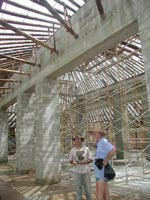 You
know you are in an out of the way part of the world when it takes
two days, two planes and two busses to get you to your destination,
not to mention two days, a four-hour panga trip plus three planes
to get you back! Little brother's visit had been on our calendar
for so long, we originally were supposed to collect him in Tahiti!
He may have thought he was getting a more economical deal our being
so much closer as the crow flies, but in fact, he may well have
been able to get to and from Tahiti quicker! Dr. Greg Wilson, not
long ago Indiana's "Elementary School Principal of the Year,"
is Don's "little brother" by four years and four inches.
He is a cheerful caring teacher and parent of two, and this would
be his first solo vacation in memory. Brothers may get older, but
from what I observed in my two-week case study, the relationship
doesn't change much from where it gelled in adolescence!
You
know you are in an out of the way part of the world when it takes
two days, two planes and two busses to get you to your destination,
not to mention two days, a four-hour panga trip plus three planes
to get you back! Little brother's visit had been on our calendar
for so long, we originally were supposed to collect him in Tahiti!
He may have thought he was getting a more economical deal our being
so much closer as the crow flies, but in fact, he may well have
been able to get to and from Tahiti quicker! Dr. Greg Wilson, not
long ago Indiana's "Elementary School Principal of the Year,"
is Don's "little brother" by four years and four inches.
He is a cheerful caring teacher and parent of two, and this would
be his first solo vacation in memory. Brothers may get older, but
from what I observed in my two-week case study, the relationship
doesn't change much from where it gelled in adolescence!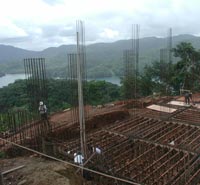 outside
the US, plus as far as we knew he had no Spanish. So, we decided
to collect Greg personally by leaving the boat in the river off
Puerto Mutis and taking the two-bus journey ourselves into Panama
City. We went a day early in order to take in the slightly delayed
Fourth of July Pig Roast Celebration at our old stomping grounds
at Pedro Miguel Boat Club. This is the first time we have "gone
back" to a place since we left Trinidad, and it was great to
see many old friends. We even got to be on hand for the happy ending
to the sad story that started March 2 (see Update #39) when our
friend John Pearlman's boat Nepenthe was one of two boats destroyed
in the worst and first Canal accident involving sailboats in fifty
years. John, still at Pedro Miguel four months later, had finally
gotten his settlement check from the Canal Commission, and he was
a relatively happy camper! Heather and Jim of sv Charmer, who are
now in charge of Pedro Miguel, put us up for the night on their
boat, and among other things this ensured, in addition to stuffing
ourselves with an absurd amount of pig, that we got a first-hand
taste of the REAL Panama rainy season. We are talking fire hydrants
here! It really puts the construction of the Canal in a perspective
we couldn't fully imagine back when it was dry season.
outside
the US, plus as far as we knew he had no Spanish. So, we decided
to collect Greg personally by leaving the boat in the river off
Puerto Mutis and taking the two-bus journey ourselves into Panama
City. We went a day early in order to take in the slightly delayed
Fourth of July Pig Roast Celebration at our old stomping grounds
at Pedro Miguel Boat Club. This is the first time we have "gone
back" to a place since we left Trinidad, and it was great to
see many old friends. We even got to be on hand for the happy ending
to the sad story that started March 2 (see Update #39) when our
friend John Pearlman's boat Nepenthe was one of two boats destroyed
in the worst and first Canal accident involving sailboats in fifty
years. John, still at Pedro Miguel four months later, had finally
gotten his settlement check from the Canal Commission, and he was
a relatively happy camper! Heather and Jim of sv Charmer, who are
now in charge of Pedro Miguel, put us up for the night on their
boat, and among other things this ensured, in addition to stuffing
ourselves with an absurd amount of pig, that we got a first-hand
taste of the REAL Panama rainy season. We are talking fire hydrants
here! It really puts the construction of the Canal in a perspective
we couldn't fully imagine back when it was dry season.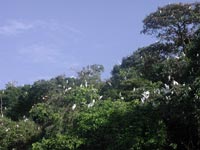 Greg's
plane landed on time about 9pm on Sunday evening, July 8 and the
ever-organized Julie Arias of Panama Yacht Services managed to get
us there right on time. Greg had been hearing a lot about how remote
we'd be, but he must have thought we were nuts based on his first
night's impression of the neon-lit Panama City skyline which could
almost be Any City, USA with all the KFCs, McDonald's Playlands
and Burger Kings. On Monday he may have got his first inkling of
third-world-ness as Don and I tried to check Tackless II formally
into the country only to be unable to as the office was out of forms!
Greg's
plane landed on time about 9pm on Sunday evening, July 8 and the
ever-organized Julie Arias of Panama Yacht Services managed to get
us there right on time. Greg had been hearing a lot about how remote
we'd be, but he must have thought we were nuts based on his first
night's impression of the neon-lit Panama City skyline which could
almost be Any City, USA with all the KFCs, McDonald's Playlands
and Burger Kings. On Monday he may have got his first inkling of
third-world-ness as Don and I tried to check Tackless II formally
into the country only to be unable to as the office was out of forms!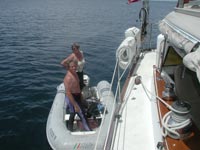 with
standing room only and our stuff on the roof. Outside the windows
he saw the landscape get simpler and simpler until we finally rolled
down into Puerto Mutis. That was Day 1.
with
standing room only and our stuff on the roof. Outside the windows
he saw the landscape get simpler and simpler until we finally rolled
down into Puerto Mutis. That was Day 1.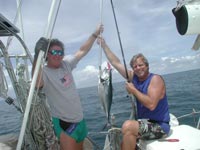 rimmed by piles of the best platacones we've had in all our travels
(platacones are slices of plantain, smashed flat and deep fried!).
The beer is cold and fifty cents apiece, and the three ladies who
run the place made much of Don's cute little brother, suggesting
maybe they should take him home and teach him some Spanish! (It
turns out our educator did have a couple years of Spanish somewhere
in his background, but it was pretty rusty.)
rimmed by piles of the best platacones we've had in all our travels
(platacones are slices of plantain, smashed flat and deep fried!).
The beer is cold and fifty cents apiece, and the three ladies who
run the place made much of Don's cute little brother, suggesting
maybe they should take him home and teach him some Spanish! (It
turns out our educator did have a couple years of Spanish somewhere
in his background, but it was pretty rusty.)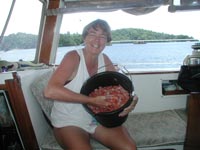 nights, and what is particularly sad is that it is not likely to
be the same the next time we pass by. It seems a couple of other
cruisers passed this way some years ago and were similarly struck
by the beauty and isolation. Only difference is they were on a big
megayacht, and they had between them the wherewithal to buy up much
of the land. Now the good news is that they are letting this land,
much of which had been cut for pasturage, grow back to its original
forest. The not-quite-so-good news is that they are building a multi-million
dollar complex of buildings here. It will not be, as you might think,
for a resort, but for a combination personal getaway cum research
facilities for foresters and biologists interested in Central American
ecology.
nights, and what is particularly sad is that it is not likely to
be the same the next time we pass by. It seems a couple of other
cruisers passed this way some years ago and were similarly struck
by the beauty and isolation. Only difference is they were on a big
megayacht, and they had between them the wherewithal to buy up much
of the land. Now the good news is that they are letting this land,
much of which had been cut for pasturage, grow back to its original
forest. The not-quite-so-good news is that they are building a multi-million
dollar complex of buildings here. It will not be, as you might think,
for a resort, but for a combination personal getaway cum research
facilities for foresters and biologists interested in Central American
ecology.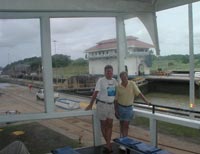 en
engine with a cog-drive transmission, very popular, we were told,
in Italy where one often can't get right of way for an access road.
(One of the owners is Italian…can we say, Fiat!) We rode up
this mini-railway with the four us of working hard to brace ourselves
upright in one of the "freight cars!" Simon tells us when
it's all finished the train will be electric with cars with seats,
and it will be the only way up! The house will cap the crest. The
foundation for a bedroom the size of most houses was well underway,
and the view was 360 degrees of magnificence. There will also be
a pool. There will be a pool, because once you are up, nobody's
gonna want to bother with that train ride down to the beach, believe
me!
en
engine with a cog-drive transmission, very popular, we were told,
in Italy where one often can't get right of way for an access road.
(One of the owners is Italian…can we say, Fiat!) We rode up
this mini-railway with the four us of working hard to brace ourselves
upright in one of the "freight cars!" Simon tells us when
it's all finished the train will be electric with cars with seats,
and it will be the only way up! The house will cap the crest. The
foundation for a bedroom the size of most houses was well underway,
and the view was 360 degrees of magnificence. There will also be
a pool. There will be a pool, because once you are up, nobody's
gonna want to bother with that train ride down to the beach, believe
me! 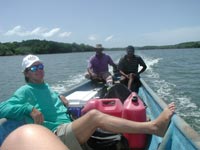 n
this area is. I looked. There really are no roads into this peninsula.
Locals travel by horse or mule. All Simon's construction materials
come by panga from Puerto Mutis, and the 26' bamboo poles are imported
from Colombia. It's the age-old dilemma for the insular romantic:
once you've built your getaway what are you going to do with yourself.
n
this area is. I looked. There really are no roads into this peninsula.
Locals travel by horse or mule. All Simon's construction materials
come by panga from Puerto Mutis, and the 26' bamboo poles are imported
from Colombia. It's the age-old dilemma for the insular romantic:
once you've built your getaway what are you going to do with yourself.
